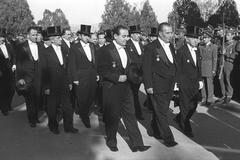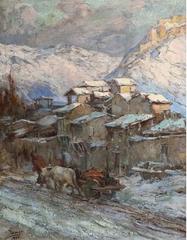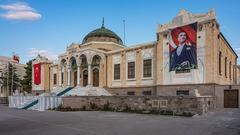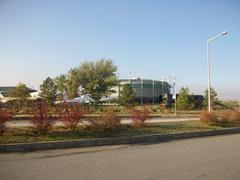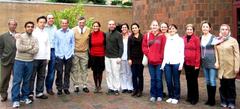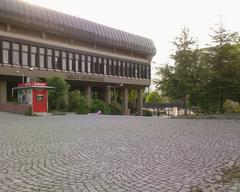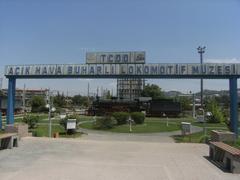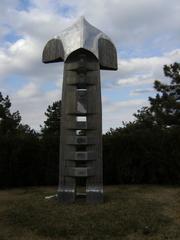Hacı Bayram Mosque: Visiting Hours, Tickets, and Historical Site Guide in Ankara
Date: 14/06/2025
Introduction
Nestled in Ankara’s historic Ulus district, the Hacı Bayram Mosque is both a spiritual sanctuary and an architectural masterpiece that embodies the rich tapestry of Turkey’s religious and cultural heritage. Constructed between 1427 and 1428 to honor the influential Sufi mystic Hacı Bayram-ı Veli, this site serves as a focal point for both worship and cultural exploration. Its remarkable location—adjacent to the Roman Temple of Augustus—offers visitors a unique intersection of Islamic and Roman legacies, making it an essential destination for anyone exploring Ankara’s historical sites (Turkey Travel Planner; travelturkey.org; Nomadic Niko).
This guide provides everything you need to know before visiting: historical background, architectural highlights, spiritual significance, detailed visitor information, and tips for making the most of your trip.
Historical Background
Origins and Construction
Commissioned in the early Ottoman period, Hacı Bayram Mosque was built between 1427 and 1428 near the tomb of Hacı Bayram-ı Veli. As the founder of the Bayrami Sufi order, Hacı Bayram-ı Veli’s teachings on unity, peace, and tolerance profoundly shaped Anatolian spirituality. The mosque’s original design reflected Seljuk architectural sensibilities, later enriched by Ottoman influences (Turkey Travel Planner; Frommer’s).
Architectural Evolution and Restorations
The mosque underwent significant renovations, most notably in 1714 under Mehmed Baba, a descendant of Hacı Bayram-ı Veli. These restorations introduced elaborate woodwork, colorful Kütahya tiles, and intricate calligraphy, preserving the mosque’s historical integrity while adapting to evolving artistic tastes (Kultur Envanteri). Most recently, the mosque was restored in 2010, ensuring accessibility and structural preservation for future generations.
Relationship with Surroundings
Hacı Bayram Mosque’s eastern wall rests against the ancient Temple of Augustus, symbolizing the continuity of Ankara’s urban and religious history. The mosque is surrounded by vibrant Ottoman-era streets, bustling bazaars, and scenic parks, offering visitors a glimpse into Ankara’s layered past (Turkey Travel Planner).
Spiritual and Social Significance
The Legacy of Hacı Bayram-ı Veli
Hacı Bayram-ı Veli (1352–1430) was a renowned Sufi scholar, poet, and spiritual leader. His teachings emphasized inner peace, social unity, and coexistence, values that continue to inspire Turkish society. The mosque, built in his honor, serves as a living testament to his enduring spiritual influence (travelturkey.org; haleema.co.uk).
Community Role
Since its inception, the mosque has functioned as more than a place of worship. It’s been a hub for education, social gatherings, and community events, fostering unity among Ankara’s diverse population. Today, it continues to be central in celebrating Islamic holidays, hosting daily prayers, and organizing religious festivities (travelturkey.org).
Pilgrimage and Commemoration
The adjacent tomb of Hacı Bayram-ı Veli makes the mosque a significant pilgrimage destination. Pilgrims gather especially during Ramadan, Eid, and the anniversary of Hacı Bayram-ı Veli’s passing, engaging in prayers, spiritual gatherings, and acts of charity (travelturkey.org).
Architectural Features
Site Layout and Context
Situated atop a tumulus near the Temple of Augustus, the mosque complex is surrounded by restored Ottoman buildings, courtyards, and lively markets. Its elevated position offers panoramic views of Ankara Castle and the city (Wikipedia; UNESCO; Nomadic Niko).
Exterior and Minaret
The mosque’s facade showcases a blend of brick and stone, with decorative calligraphic panels and geometric motifs. Its single minaret, featuring a square stone base and cylindrical shaft with two balconies, is a distinctive architectural highlight (Thrillophilia; Live the World).
Interior Highlights
- Prayer Hall: The spacious prayer hall, accommodating around 4,500 worshippers, features a wooden ceiling, upper windows with floral motifs, and vibrant Kütahya tiles.
- Mihrab and Minbar: The mihrab is adorned with ornate tilework and calligraphy, while the minbar boasts intricate Ottoman woodcarving.
- Decorative Elements: Calligraphic inscriptions, geometric woodwork, and painted ceilings reflect Seljuk and Ottoman artistry (Kultur Envanteri; Nomadic Niko).
Mausoleum of Hacı Bayram-ı Veli
Connected to the mosque’s southern section, the mausoleum (türbe) is a revered site for visitors and pilgrims. Renovated in 1947, it features elegant tilework and commemorative inscriptions (UNESCO).
Integration with the Temple of Augustus
The mosque’s proximity to the Roman Temple of Augustus, with its Monumentum Ancyranum inscription, vividly illustrates Ankara’s multi-layered heritage (Rough Guides; UNESCO).
Visitor Information
Location and Accessibility
The mosque is centrally located in Ulus, easily accessible via:
- Metro: Ulus station (5-minute walk)
- Bus: Multiple city routes stop nearby
- Taxi/Ride-sharing: Available citywide (HalalTrip)
The site is wheelchair accessible, with ramps and paved pathways.
Visiting Hours
- Standard Hours: Open daily, generally 24 hours; visitors are welcome during daylight hours.
- Best Times: Early mornings or late afternoons are quieter. Avoid Friday midday prayers and major Islamic holidays for a less crowded experience (Thrillophilia; HalalTrip).
Tickets and Admission
- Entry: Free of charge; no tickets required
- Donations: Appreciated for mosque maintenance
Dress Code and Etiquette
- Modest dress is required; women should cover their heads, arms, and legs.
- Shoes must be removed before entering the prayer hall.
- Maintain respectful behavior and avoid photography during prayers or of worshippers without permission (HalalTrip).
Guided Tours
Guided and self-guided tours are available via local operators and apps such as GPSmyCity, which offers offline maps and commentary (GPSmyCity).
Surrounding Area and Nearby Attractions
The Ulus district offers:
- Temple of Augustus
- Ankara Castle
- Museum of Anatolian Civilizations
- Roman Baths
- Traditional bazaars, cafes, and souvenir shops
Nearby restaurants provide halal dining options, and the area is known for its vibrant local culture (MakeMyTrip; VisitTurkey.in).
Events and Community Engagement
Hacı Bayram Mosque hosts:
- Ramadan: Nightly tarawih prayers and communal iftar meals
- Eid Celebrations: Special prayers and festivities
- Commemorations: Annual events marking Hacı Bayram-ı Veli’s legacy (travelturkey.org)
These gatherings foster spiritual renewal and cultural continuity.
Photography and Souvenirs
- Photography: Allowed in courtyards and outdoors; restricted during prayers or without consent inside the prayer hall.
- Souvenirs: Shops offer prayer beads, calligraphy, books, and textiles (MakeMyTrip).
Safety and Sustainable Tourism
The Ulus area is safe and well-patrolled. Support sustainable tourism by patronizing local businesses and respecting the site’s cultural and religious significance (VisitTurkey.in).
FAQs
Q: What are the visiting hours?
A: The mosque is generally open 24 hours, but visiting outside prayer times is recommended.
Q: Is there an entrance fee?
A: No, entry is free.
Q: Are guided tours available?
A: Yes, via local operators and mobile apps.
Q: How do I get there?
A: Ulus metro station is nearby; taxis and buses are also convenient.
Q: Is the mosque accessible?
A: Yes, ramps and paved paths are available.
Q: What should I wear?
A: Modest clothing; women should cover their heads, arms, and legs.
Visuals and Media Suggestions
Explore online virtual tours, high-quality images, and district maps to plan your visit. Interactive guides and mobile apps enhance your experience.
Conclusion
Hacı Bayram Mosque is a living monument to Ankara’s spiritual, architectural, and communal legacy. Its harmonious blend of Ottoman and Seljuk styles, proximity to the Roman Temple of Augustus, and active role in community life make it a must-visit for anyone exploring Turkey’s capital. With free entry, accessible facilities, and a vibrant surrounding district, the mosque invites visitors to connect with Ankara’s cultural roots and spiritual traditions.
Call to Action
Plan your visit to Hacı Bayram Mosque today! Download the Audiala app for guided tours, current hours, and exclusive insights. For more on Ankara’s historical sites, follow us on social media and explore related articles.
Sources and Further Reading
- Turkey Travel Planner - Hacı Bayram Mosque
- travelturkey.org - Hacı Bayram Mosque
- Nomadic Niko - Hacı Bayram Mosque
- Frommer’s - Hacı Bayram Mosque
- Kultur Envanteri - Hacı Bayram Mosque
- Wikipedia - Hacı Bayram Mosque
- UNESCO - Hacı Bayram Mosque
- Thrillophilia - Hacı Bayram Mosque
- Live the World - Hacı Bayram Mosque
- HalalTrip - Hacı Bayram Mosque
- MakeMyTrip - Hacı Bayram Mosque
- VisitTurkey.in
- GPSmyCity - Hacı Bayram Mosque
- Rough Guides - Things to do in Ankara
